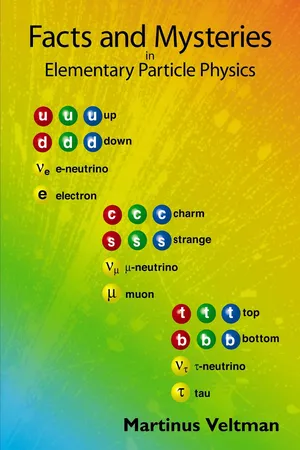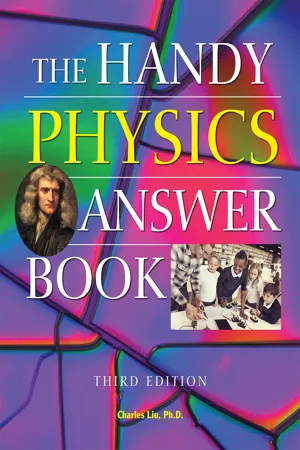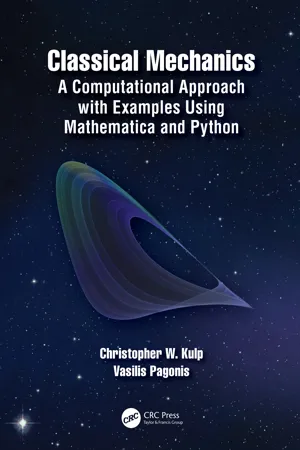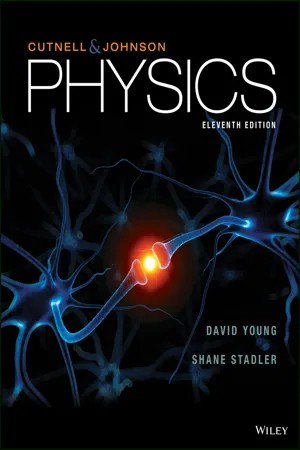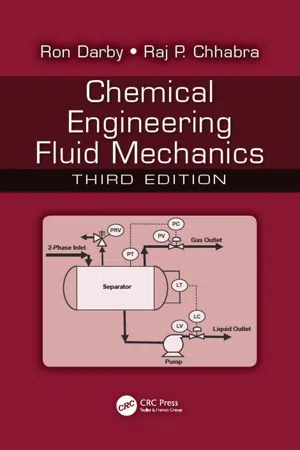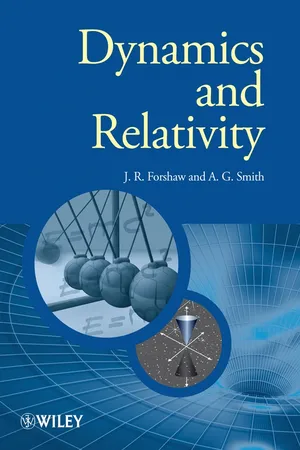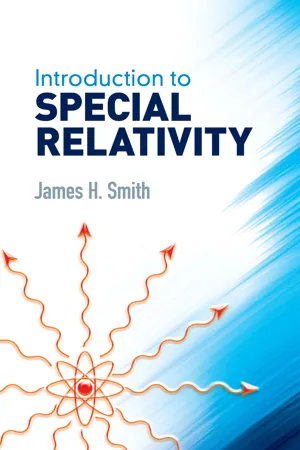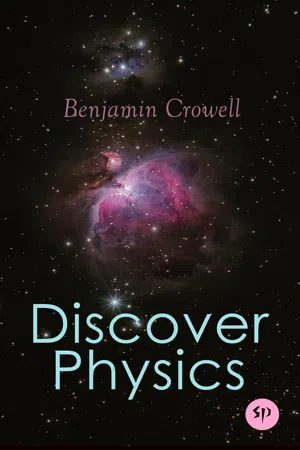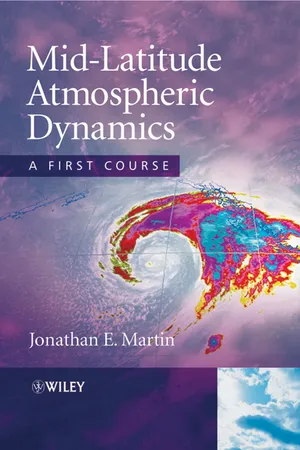Physics
Conservation of Energy and Momentum
The conservation of energy and momentum is a fundamental principle in physics stating that the total amount of energy and momentum in a closed system remains constant over time, provided no external forces act on it. This principle is crucial for understanding and predicting the behavior of physical systems, from simple collisions to complex interactions in the universe.
Written by Perlego with AI-assistance
Related key terms
Related key terms
1 of 4
Related key terms
1 of 3
10 Key excerpts on "Conservation of Energy and Momentum"
- eBook - ePub
Doing Physics with Scientific Notebook
A Problem Solving Approach
- Joseph Gallant(Author)
- 2012(Publication Date)
- Wiley(Publisher)
Chapter 6Conservation Laws
Conservation Laws are fundamentally important in physics. We say a quantity is “conserved” when its total amount never changes. Its initial value equals its final value equals its value at all times in between. In this chapter you’ll meet two of the most important conserved quantities, Energy and Momentum.Conservation laws are also powerful problem-solving tools. Even though they are consequences of Newton’s Laws, the approach to using them is different than the cause-and-effect methods of the last chapter. When we used Newton’s 2nd Law, we applied it to each object separately. When we use a conservation law, we’ll look at the system as a whole, not at the individual parts, and keep track of the total amount of the conserved quantity. Still, our goal is the same: to understand and explain changes in motion.Definitions
To understand and explain changes in motion, we need to consider both velocity and mass. Stopping a train moving at 5 mi/h is not the same as stopping an empty shopping cart moving at 5 mi/h. They have the same speed, but not the same mass. Catching a baseball moving at 5 mi/h is not the same as catching one moving at 100 mi/h. They have the same mass, but not the same speed.We can define a new vector called momentum as the product of mass times velocity. This is such a useful and important concept that when Newton used the word “motion” in the Principia, he often meant what we today call momentum.(6.1)The magnitude of the momentum is p = mv and its direction is the same as the velocity vector. The metric unit of momentum is the kg m/s.Calculate the momentum of a 1500 kg car moving at a speed of 15 mi/h. Do the same for a baseball moving at a speed of 80 mi/h. Which has more momentum?Example 6.1Some typical valuesSolution.Use Eq. (6.1) to create an expression for the car’s momentum using the given values. Select the car’s velocity and apply Evaluate Numerically in-place to convert it to meters per second, then Evaluate - Martinus J G Veltman(Author)
- 2003(Publication Date)
- WSPC(Publisher)
Energy, Momentum and Mass-Shell 4.1 Introduction The aim of this Chapter is to explain the mechanical properties of elementary particles that will form the basis of much that we shall be discussing. In particular, it is necessary to have a good understanding of momentum and energy, and, for a single particle, the relation between the two, called the mass-shell relation. Energy and momentum are important concepts because of two facts: first they are, in the context of quantum mechanics, enough to describe completely the state of a single free particle (disregarding internal properties such as spin and charge), and second, they are conserved. For energy this is well known: for any observable process the initial energy equals the final energy. It may be distributed differently, or have a different form, but no energy disappears. If we burn wood in a stove the chemical energy locked in the wood changes into heat that warms the space where the stove is burning; eventually this heat dissipates to the outside, but does not disappear. This is the law of conservation of energy. Similarly there is a law for conservation of momentum and we shall try to explain that in this section for simple collision processes. The fact that a description of the state of a particle in terms of its energy and momentum is a complete description is very much at the heart of quantum mechanics. Normally we specify the state of a particle by its position and its momentum at a given time: where, when and how does it move. Momentum a is a vector, meaning that it has a direction: momentum has thus three components, momentum in the x, y and z directions. That means that for the specification of the state of a particle we have three space coordinates plus the time and the three components of the momentum. In quantum mechanics, when you know precisely the momentum of a particle no information on its location can be given. Heisenberg’s famous uncertainty relation forbids this- eBook - ePub
- Charles Liu(Author)
- 2020(Publication Date)
- Visible Ink Press(Publisher)
The toy Newton’s Cradle has a set of steel balls that swing on strings. In these elastic collisions, kinetic energy is almost totally conserved. The incoming ball stops when it hits a second ball, and the second ball moves away with the same speed, and thus kinetic energy, as the incoming ball had. Billiard balls (or pool balls) colliding on a pool table provide another case where kinetic energy is conserved.An example of an inelastic collision is throwing a snowball into a snowman. The snowball doesn’t bounce but sticks to the snowman. Another example would be dropping a golf ball into a mud puddle; rather than bouncing back up, the golf ball lands into the soft mud and just stays there.How are conservation of energy and conservation of momentum used in everyday life?
These two physics principles are most often used to examine what happens when two or more objects collide. Momentum is conserved if there are no external forces, and it changes very little if the forces during the collision are much greater than the external forces. For example, if two cars collide, the two cars are the system. The forces between them are much larger than the forces on the wheels that come from outside the system, so momentum is conserved. Is energy conserved? While total energy is conserved, the kinetic energy before the collision is much greater than the energy afterward. Much of the energy goes into bending metal and breaking glass and plastic. Automobile crash reconstruction is a way of using conservation of momentum to figure out the speeds of one or both of the cars before the collision.Who further developed the idea of conservation of energy?
The physicist Benjamin Thompson (1753–1814) was born in Massachusetts, but because he opposed the American Revolution, he left for England and was knighted by King George III and given the title Count Rumford. While in America, he spied for the British. While in England, he spied for the French and was a counterspy for the British. He moved to Bavaria, now part of Germany, and became minister of war, among other duties. Because he ran an orphanage and wanted to save money, he studied heat and invented many items, like an efficient stove and a coffee percolator. A long series of experiments led Rumford to conclude in 1798 that thermal energy was nothing more than the vibratory motion of what we know today as the atoms that make up the material. - eBook - ePub
Classical Mechanics
A Computational Approach with Examples Using Mathematica and Python
- Christopher W. Kulp, Vasilis Pagonis(Authors)
- 2020(Publication Date)
- CRC Press(Publisher)
CHAPTER 4Momentum, Angular Momentum, and Multiparticle SystemsIn this chapter, we focus on two important physical quantities: linear momentum and angular momentum. Under certain conditions, as explained in this chapter, momentum and angular momentum are conserved quantities, meaning that their values are constant during a physical process. The conservation of momentum or angular momentum can then be used to solve problems by comparing the state of a system before a physical process to the state of that same system after this process. In this chapter, we will also study multiparticle systems, continuous mass distributions (i.e., systems that are not point particles), and center of mass. We develop relationships between the total momentum of a system of particles to the momentum of the system’s center of mass. We also develop a relationship between the angular momentum of a system of particles to angular momentum of the system’s center of mass. We will show that these relationships will also hold for continuous mass distributions. Finally, we discuss numerical integration techniques which will be useful when finding a system’s center of mass.4.1Conservation of momentum and Newton’s third lawRecall that Newton’s third law states that if Particle 1 exerts a force F21 on Particle 2, then Particle 2 exerts a force F12 on Particle 1 such that:F 12= −F 21(4.1.1) Newton’s third law will lead us to an interesting result. Consider two particles interacting via a force, which we will refer to as an “internal force.” For example, if our two objects are the Earth and Moon, their gravitational interaction would be the internal force. Furthermore, assume that each particle is experiencing an external force due to other bodies outside of the system. In the case of the Earth and the Moon, that could be the Sun’s gravitational force, a body outside the Earth-Moon system. The net force F1 - eBook - ePub
- John D. Cutnell, Kenneth W. Johnson, David Young, Shane Stadler(Authors)
- 2018(Publication Date)
- Wiley(Publisher)
An isolated system is one for which the vector sum of the external forces acting on the system is zero. The principle of conservation of linear momentum states that the total linear momentum of an isolated system remains constant. For a two-body system, the conservation of linear momentum can be written as in Equation 7.7b, where m 1 and m 2 are the masses, v → f 1 and v → f 2 are the final velocities, and v → 01 and v → 02 are the initial velocities of the objects. (7.7b) m 1 v → f 1 + m 2 v → f 2 ⏟ Final total linear momentum = m 1 v → 01 + m 2 v → 02 ⏟ Initial total linear momentum 7.3 Collisions in One Dimension An elastic collision is one in which the total kinetic energy of the system after the collision is equal to the total kinetic energy of the system before the collision. An inelastic collision is one in which the total kinetic energy of the system is not the same before and after the collision. If the objects stick together after the collision, the collision is said to be completely inelastic. 7.4 Collisions in Two Dimensions When the total linear momentum is conserved in a two-dimensional collision, the x and y components of the total linear momentum are conserved separately. For a collision between two objects, the conservation of total linear momentum can be written as in Equations 7.9a and 7.9b. (7.9a) m 1 v f 1 x + m 2 v f 2 x ⏟ x component of final total linear momentum = m 1 v 01 x + m 2 v 02 x ⏟ x component of initial total linear momentum (7.9b) m 1 v f 1 y + m 2 v f 2 y ⏟ y component of final total linear momentum = m 1 v 01 y + m 2 v 02 y ⏟ y component of. initial total linear momentum 7.5 Center of Mass The location of the center of mass of two particles lying on the x axis is given by Equation 7.10, where m 1 and m 2 are the masses of the particles and x 1 and x 2 are their positions relative to the coordinate origin. If the particles move with velocities v 1 and v 2, the velocity v cm of the center of mass is given by Equation 7.11 - eBook - ePub
- Ron Darby, Raj P. Chhabra(Authors)
- 2016(Publication Date)
- CRC Press(Publisher)
5 Conservation Principles“As simple as possible, but no simpler.”—Albert Einstein, 1879–1955, PhysicistI. THE SYSTEMAs discussed in Chapter 1 , the basic principles that apply to the analysis and solution of flow problems include the conservation of mass, energy, and momentum, in addition to appropriate transport relations for these conserved quantities. For flow problems, these conservation laws are applied to a system, which is defined as any clearly specified region or volume of fluid with either macroscopic or microscopic dimensions (this is also sometimes referred to as a “control volume”), as illustrated in Figure 5.1 . The material (fluid) within the system is assumed to be a continuum, with physical properties that can be defined at all points within the system. This means that only dimensions which are very large compared to the molecular or particulate structure of the material are considered. The general conservation law is{−}Rate of Xinto the system{=}Rate of Xout of the system{Rate of accumulation}of X in the systemwhere X is the conserved quantity, that is, mass, energy, or momentum. In the case of momentum, because a “rate of momentum” is equivalent to a force (by Newton’s second law), the “rate in” term must also include any (net) forces acting on the system. It is emphasized that the system is not the “containing vessel”per se (e.g., a pipe, tank, or pump) but is the fluid contained within the designated boundary. We will show how this generic expression is applied for each of the conserved quantities.II. CONSERVATION OF MASSA. MACROSCOPIC MASS BALANCEFor a given system (e.g., Figure 5.1 ), each entering stream (i) will carry mass into the system (at rate ṁi) and each exiting stream (o) carries mass out of the system (at rate ṁo). Hence, the conservation of mass, or “continuity,” equation for the system is∑i n−m ˙i=∑o u tm ˙odm sd t(5.1) where ms - eBook - ePub
- Jeffrey Forshaw, Gavin Smith(Authors)
- 2014(Publication Date)
- Wiley(Publisher)
The initial state is similar to that described in the previous example, although we must be careful with the vector nature of the velocities. Momentum conservation now giveswhere v is the velocity of the beam particles and and are the final velocity vectors. Taking the scalar product of each side with itself (“squaring ”) giveswhere ϕ is the angle between the final velocity vectors. Invoking energy conservation for an elastic collision we have and thereforeSince both final speeds are non-zero we must have cos ϕ = 0 and we conclude that the final velocity vectors form a right-angle in the lab frame.3.4 ENERGY CONSERVATION IN COMPLEX SYSTEMS
Consider what happens when you drop a heavy stone on a sandy beach. Initially the stone has gravitational potential energy, which converts into kinetic energy as the stone falls. When the stone hits the beach, the grains of sand are given kinetic energy in the collision and they jostle against each other briefly, but in a very short time everything comes to rest with the stone embedded in the sand. Where does the energy go? We could say that friction acts between the stone and the sand, and since friction is a non-conservative force the total mechanical energy of the stone is not a constant of the motion once the stone hits the sand. But that is not to answer the question.You might be familiar with the heating that occurs when an electric drill is used on a resilient surface, such as brick or ceramic tiles: the drill bit can become too hot to handle. This type of experience demonstrates clearly that heat can result from motion. In a series of careful experiments, Joule showed that heat could be regarded as a form of energy and that a loss of mechanical energy could be associated with a predictable temperature rise. In effect Joule demonstrated that the conservation of energy can be rescued provided we are prepared to count thermal energy when we are doing the book-keeping. So, when considering the stone that falls into the sand we can now say that the total energy is conserved but that mechanical energy is transformed into thermal energy as a result of the collision, and that we expect a rise in temperature of the sand and stone that depends on the amount of mechanical energy dissipated in the collision. - eBook - ePub
- James H. Smith(Author)
- 2016(Publication Date)
- Dover Publications(Publisher)
Equation 9-8 does not violate the first postulate of relativity. That is, if one observer finds it to be true, then all observers will do so. Whether or not conservation of this quantity is actually observed in nature must be left to experiment to decide.9-4 A NEW CONSERVATION LAW: ENERGYHaving decided that conservation of momentum, as expressed by Equation 9-8 , does not violate the relativity postulate, and deferring the discussion of experimental verification, we proceed to investigate the consequences of this law by considering how two observers would describe the conservation of momentum along the direction of their relative motion, the x-direction.The observer ofor in terms of the proper velocitiesFigure 9-1bwould write down conservation of momentum in the x-direction asIn order to see what this implies for the observer ofFigure 9-1a, this must be written in terms of velocities as measured by him. The transformation of the x-component of proper velocity is given by Equation 8-6 :Here it has been assumed that the relative speed of the observers inFigure 9-1aand b is βc , and has been written for η0a in order to make the expression more explicit. Substitution of this and similar expressions for the other particles in Equation 9-12 givesThe expression in the first parenthesis is zero since it just expresses conservation of the x-component of momentum in the unprimed frame of reference. This we have already assumed. However, if momentum is to be conserved in both frames of reference, the expression in the second parenthesis must also be zero. This means thatIn other words, the quantity , summed over all the particles, must be the same before and after the collision, i.e., it must be conserved. This should not be surprising. The requirement arises in exactly the same way that mass conservation did in the non-relativistic case. In fact, for low speeds, the quantity reduces to the mass of the particle. For this and other related reasons the quantity is often called the “mass” of a moving particle. We shall temporarily denote this “mass” by . In this case m would be referred to as the “rest mass” of the particle, the mass it would have when at rest. In this notation the relativistic momentum becomes , its classical form, and Equation 9-14 - eBook - ePub
- Benjamin Crowell(Author)
- 2018(Publication Date)
- Studium Publishing(Publisher)
What is energy? It’s hard to give a pithy, clear definition. In a published lecture, physicist Richard Feynman wrote, “It is important to realize that in physics today, we have no knowledge of what energy is.” Conservation of energy, he wrote, “states that there is a certain quantity, which we call energy, that does not change in the manifold changes which nature undergoes... It is not a description of a mechanism, or anything concrete; it is just a strange fact that we can calculate some number and when we finish watching nature go through her tricks and calculate the number again, it is the same. (Something like the bishop on a red square, and after a number of moves — details unknown — it is still on some red square...)” In fact, all the conserved quantities have this elusive quality, but it’s just more obvious when it comes to energy. Nineteenth-century physicists thought they knew what momentum was, but they found out later that there was a less obvious form of it, which they had left out of their definition: light carries momentum, just not enough to notice in everyday life. Twentieth-century physicists thought they knew what mass was, but recent astronomical observations have shown that 95% of the universe’s mass is in the form of “dark matter,” which isn’t really matter at all, in the usual sense of protons, neutrons, and electrons. Mass, momentum, and energy are not things that were revealed to physicists centuries ago on stone tablets. Physicists had to determine by experiment what forms they took, and what mathematical rules to use for calculating each of these forms. To see how this open-ended process works, we’re going to pretend that we only know about gravitational energy, and see how we can extend energy to include a new form, kinetic energy.We already know about gravitational energy, which is useful all by itself. For instance, if two children are balanced on a see-saw, the total gravitational energy remains the same as one goes up and the other goes down. What if they’re unbalanced? If the heavier child sits down first, the lighter one will not be able to budge the see-saw by sitting down on the other end. Again, our theory works: motion is impossible in this situation, because energy would not be conserved: if the heavier child went up and the lighter child went down, the total energy would not stay the same.But nothing is as sad as a beautiful theory confronted with an ugly fact. If the lighter child gets on first, and then the heavier one, we do get motion. Since gravitational energy is the only form of energy we know about, our theory is violated. As the heavy child falls, and the light one rises an equal distance, we are losing total gravitational energy. The only way to fix our broken theory is to notice that in this new process, unlike the previous ones, there is a change in speed. We therefore hypothesize that there is some new form of energy, which is possessed by objects in motion. The net loss in gravitational is, we guess, canceled by a gain in total motion-of-energy, which we decide to call kinetic energy. - eBook - ePub
Mid-Latitude Atmospheric Dynamics
A First Course
- Jonathan E. Martin(Author)
- 2013(Publication Date)
- Wiley(Publisher)
3Mass, Momentum, and Energy: The Fundamental Quantities of the Physical World
Objectives
Study of the physical world tends to be focused on the quantities known as mass, momentum, and energy. The behavior of the atmosphere is no exception to this rule. In this chapter we will investigate the manner in which these quantities and their various interactions serve to describe the building blocks of a dynamical understanding of the atmosphere at middle latitudes. We must first consider the distribution of mass in the atmosphere and the force balance that underlies this distribution. A number of insights concerning the vertical structure of the atmosphere proceed directly from this understanding.Beginning with Newton’s second law, we will construct expressions for the conservation of momentum in the three Cartesian directions. These expressions are commonly known as the equations of motion and will serve as the fundamental set of physical relationships for all subsequent inquiry in this book. Scale analysis of the horizontal equations of motion will reveal that a simple diagnostic relationship between the mass and momentum fields, geostrophy, characterizes the mid-latitude atmosphere on Earth. Finally, employing these equations of motion we will develop expressions for the conservation of mass and the conservation of energy. We begin by considering the distribution of mass in the atmosphere.3.1 Mass in the Atmosphere
For our purposes, we shall define mass as the measure of the substance of an object and make that measurement in kilograms (kg). Though it was not clear to ancient thinkers like Aristotle,1 the atmosphere has mass. In fact the Earth’s atmosphere has a mass of 5.265 × 1018
Index pages curate the most relevant extracts from our library of academic textbooks. They’ve been created using an in-house natural language model (NLM), each adding context and meaning to key research topics.
Explore more topic indexes
Explore more topic indexes
1 of 6
Explore more topic indexes
1 of 4

